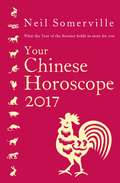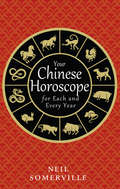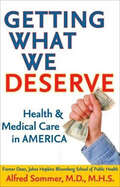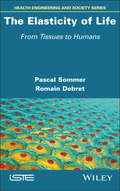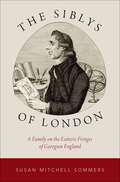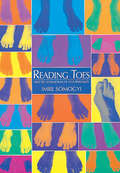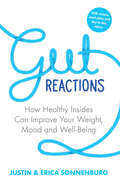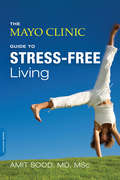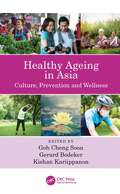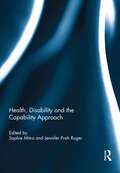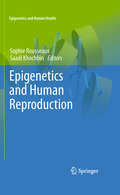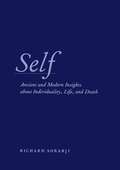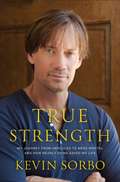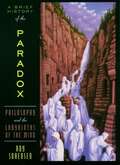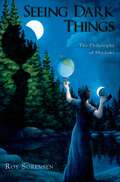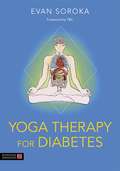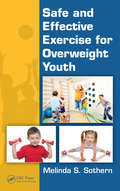- Table View
- List View
Your Chinese Horoscope 2017: What The Year Of The Rooster Holds In Store For You
by Neil SomervilleThe year 2017 is the Chinese Year of the Rooster – what will this mean for you? This complete guide contains all the predictions you will need to take you into the year ahead – an interesting year offering scope, awareness and much possibility.
Your Chinese Horoscope for Each and Every Year
by Neil SomervilleYour Chinese Horoscope for Each and Every Year is a helpful and informative guide on Chinese horoscopes. Built on the long-standing success of Your Chinese Horoscope, this new book gives insights into each of the Chinese signs as well as special success tips to help readers make the most of their sign.
Getting What We Deserve: Health and Medical Care in America
by Alfred SommerOne of America's leading public health experts finds a host of ills in this country's health care system:• The United States spends nearly twice as much on health care as the rest of the developed world, yet has higher infant mortality rates and shorter longevity than most nations.• We have access to many different drugs that accomplish the same end at varying costs, and nearly all are cheaper abroad.• Our life span had doubled over the past century before we developed effective drugs to treat most diseases or even considered altering the human genome.• The benefits of almost all newly developed treatments are marginal, while their costs are high.In his blunt assessment of the state of public health in America, Alfred Sommer argues that human behavior has a stronger effect on wellness than almost any other factor.Despite exciting advances in genomic research and cutting-edge medicine, Sommer explains, most illness can be avoided or managed with simple, low-tech habits such as proper hand washing, regular exercise, a balanced diet, and not smoking. But, as he also shows, this is easier said than done.Sommer finds that our fascination with medical advances sometimes keeps us from taking responsibility for our individual well-being. Instead of focusing on prevention, we wait for medical science to cure us once we become sick.Humorous, sometimes acerbic, and always well informed, Sommer's thought-provoking book will change the way you look at health care in America.
The Elasticity of Life: From Tissues to Humans
by Pascal Sommer Romain DebretElasticity is absolutely necessary for living a normal life. This fact is cruelly revealed when respiratory, cardiac, digestive, sensory, motor, reproductive or aesthetic problems appear following the inexorable decline of our elastic capital. The protection and maintenance of this capital is one of life’s priorities since this declination begins at the age of twenty and accelerates in times of crises and pandemics. However, there are no therapies yet designed to remedy it. The first part of the book explains the consequences surrounding a lack of elasticity in the skin, the most visible decline, and then other defects in elasticity throughout our bodies, exploring places rarely mentioned. The second part describes the research fighting against elasticity anomalies and examines useful behaviors to protect our elastic capital (e.g. our diets and physical and cognitive activities). This last point is at the heart of current social debates on nutritional, behavioral, environmental and even ethical levels.
The Elasticity of Life: From Tissues to Humans
by Pascal Sommer Romain DebretElasticity is absolutely necessary for living a normal life. This fact is cruelly revealed when respiratory, cardiac, digestive, sensory, motor, reproductive or aesthetic problems appear following the inexorable decline of our elastic capital. The protection and maintenance of this capital is one of life’s priorities since this declination begins at the age of twenty and accelerates in times of crises and pandemics. However, there are no therapies yet designed to remedy it. The first part of the book explains the consequences surrounding a lack of elasticity in the skin, the most visible decline, and then other defects in elasticity throughout our bodies, exploring places rarely mentioned. The second part describes the research fighting against elasticity anomalies and examines useful behaviors to protect our elastic capital (e.g. our diets and physical and cognitive activities). This last point is at the heart of current social debates on nutritional, behavioral, environmental and even ethical levels.
The Siblys of London: A Family on the Esoteric Fringes of Georgian England (Oxford Studies in Western Esotericism)
by Susan SommersEbenezer Sibly was a quack doctor, plagiarist, and masonic ritualist in late eighteenth-century London; his brother Manoah was a respectable accountant and a pastor who ministered to his congregation without pay for fifty years. The inventor of Dr. Sibly's Reanimating Solar Tincture, which claimed to restore the newly dead to life, Ebenezer himself died before he turned fifty and stayed that way despite being surrounded by bottles of the stuff. Asked to execute his will, which urged the continued manufacture of Solar Tincture, and left legacies for multiple and concurrent wives as well as an illegitimate son whose name the deceased could not recall, Manoah found his brother's record of financial and moral indiscretions so upsetting that he immediately resigned his executorship. Ebenezer's death brought a premature conclusion to a colorfully chaotic life, lived on the fringes of various interwoven esoteric subcultures. Drawing on such sources as ratebooks and pollbooks, personal letters and published sermons, burial registers and horoscopes, Susan Mitchell Sommers has woven together an engaging microhistory that offers useful revisions to scholarly accounts of Ebenezer and Manoah, while placing the entire Sibly family firmly in the esoteric byways of the eighteenth and early nineteenth centuries. The Siblys of London provides fascinating insight into the lives of a family who lived just outside our usual historical range of vision.
The Siblys of London: A Family on the Esoteric Fringes of Georgian England (Oxford Studies in Western Esotericism)
by Susan SommersEbenezer Sibly was a quack doctor, plagiarist, and masonic ritualist in late eighteenth-century London; his brother Manoah was a respectable accountant and a pastor who ministered to his congregation without pay for fifty years. The inventor of Dr. Sibly's Reanimating Solar Tincture, which claimed to restore the newly dead to life, Ebenezer himself died before he turned fifty and stayed that way despite being surrounded by bottles of the stuff. Asked to execute his will, which urged the continued manufacture of Solar Tincture, and left legacies for multiple and concurrent wives as well as an illegitimate son whose name the deceased could not recall, Manoah found his brother's record of financial and moral indiscretions so upsetting that he immediately resigned his executorship. Ebenezer's death brought a premature conclusion to a colorfully chaotic life, lived on the fringes of various interwoven esoteric subcultures. Drawing on such sources as ratebooks and pollbooks, personal letters and published sermons, burial registers and horoscopes, Susan Mitchell Sommers has woven together an engaging microhistory that offers useful revisions to scholarly accounts of Ebenezer and Manoah, while placing the entire Sibly family firmly in the esoteric byways of the eighteenth and early nineteenth centuries. The Siblys of London provides fascinating insight into the lives of a family who lived just outside our usual historical range of vision.
Reading Toes: Your Feet As Reflections Of Your Personality
by Imre SomogyiThe author has developed a theory that toes are mirrors and the shape and position of toes shows who you are. This book explains the theory and shows how to read toes.
Gut Reactions: How Healthy Insides Can Improve Your Weight, Mood and Well-Being
by Justin Sonnenburg Erica Sonnenburg"The link between our biomes, gut bacteria and our overall health is the final frontier of medicine that we must now embrace if we are ever to advance as a profession ... This book comes at the perfect time!"Dr Christian Jessen, presenter of 'Embarrassing Bodies' and 'Supersize vs. Superskinny'From your weight, to how you age, to allergies and diseases - your gut controls it all.In Gut Reactions, leading scientists Justin and Erica Sonnenberg explain how we've neglected this vital organ for far too long. As well as the consequences you might expect - a dramatic rise in food intolerances and inflammatory bowel diseases - are a whole host of other concerns, such as an increase in cancer, asthma, autism and diabetes. We now have only 1,200 species of microbes living in our gut. We used to have many more. Why are these species becoming extinct? And how do we prevent it?With recipes and meal plans, as well as guidance on alternatives to antibiotics and lifestyle choices, Gut Reactions will help you to interpret, understand and incorporate these new radical findings into your diet and lifestyle and will help you on your journey to a healthier gut.PREVIOUSLY PUBLISHED AS THE GOOD GUT
The Mayo Clinic Guide to Stress-Free Living
by Amit Sood Mayo ClinicHave you ever driven several miles without noticing anything on the road, or read a page in a book without registering any of it? Do the day's worries and disappointments crowd your mind as you're trying to fall asleep at night? Do you feel stressed much of the time and aren't sure how to find peace? In this book, Amit Sood, M.D., M.Sc., a Mayo Clinic specialist in stress and resiliency, reveals how the mind's instinctive restlessness and shortsightedness generate stress and anxiety and presents strategies for living a more peaceful life. The book is based on the highly popular stress management program offered at Mayo Clinic that Dr. Sood developed after two decades of work with tens of thousands of people.Drawing on groundbreaking brain research, Dr. Sood helps you understand the brain's two modes and how an imbalance between them produces unwanted stress. From this basis, you learn skills that will help you: Develop deep and sustained attention Practice gratitude, compassion and acceptance Live a meaningful life Cultivate nurturing relationships Achieve your highest potentialAll of these concepts are weaved into a practical and fun journey that has been tested in numerous scientific studies, with consistently positive results. Take the first step to discover greater peace and joy for you and your loved ones."Dr. Sood has put together a simple, secular and structured program that is anchored in science, is free of rituals and dogmas, and is accessible to everyone. This book can change your life."--Dr. Andrew Weil"An important innovative approach to well-being, one we all should know about."--Dr. Daniel Goleman
The Mayo Clinic Guide to Stress-Free Living
by Amit Sood Mayo ClinicIn this book, Amit Sood, M.D., M.Sc., a Mayo Clinic specialist in stress and resiliency, reveals how the mind's instinctive restlessness and shortsightedness generate stress and anxiety and presents strategies for living a more peaceful life.Have you ever driven several miles without noticing anything on the road, or read a page in a book without registering any of it? Do the day's worries and disappointments crowd your mind as you're trying to fall asleep at night? Do you feel stressed much of the time and aren't sure how to find peace? This book is based on the highly popular stress management program offered at Mayo Clinic that Dr. Sood developed after two decades of work with tens of thousands of people. Drawing on groundbreaking brain research, Dr. Sood helps you understand the brain's two modes and how an imbalance between them produces unwanted stress. From this basis, you learn skills that will help you:Develop deep and sustained attentionPractice gratitude, compassion and acceptanceLive a meaningful lifeCultivate nurturing relationshipsAchieve your highest potentialAll of these concepts are weaved into a practical and fun journey that has been tested in numerous scientific studies, with consistently positive results. Take the first step to discover greater peace and joy for you and your loved ones."Dr. Sood has put together a simple, secular and structured program that is anchored in science, is free of rituals and dogmas, and is accessible to everyone. This book can change your life." -- Dr. Andrew Weil"An important innovative approach to well-being, one we all should know about." -- Dr. Daniel Goleman
Healthy Ageing in Asia: Culture, Prevention and Wellness
by Goh Cheng Soon Gerard Bodeker Kishan KariippanonAsia is the world’s most populous region and has the highest per capita number of older people in the world. It is also home to the healthy ageing traditions of Ayurveda and Chinese Medicine and the rich regional traditions of Japan, Korea, Southeast Asia, and South Asia. This book addresses policies related to ageing, traditional Asian approaches to ageing, an integrated medical system approaches to ageing, ageing in place, and community empowerment. Features Presents information on The 100-Year Life. As a counterpoint to focussing on the frail elderly, Japan is promoting the ‘100-Year Life Society’, a societal model in which all citizens are dynamically engaged and productive throughout the lifespan to reach a healthy 100 years of age. Discusses a framework for optimization of Ageing in Place or staying at home as this is a desired option for most older people. Presents evidence for exercise and movement in healthy aging with guidelines in different states of ageing. Features information on how to improve mental wellbeing in cognitive decline, isolation and loneliness, poor nutrition, and reduced mobility. Creates an understanding of loss and bereavement through processes and the impact of loss. Provides information on developments in health technology to optimize efficiency, accuracy, and effectiveness of providers. Details health insurance options including coverage for traditional as well as modern medical services, provides models for other countries in the region. Lists coping skills or abilities to help older people to be more independent and in control of their lives. Features information on Asian herbs, spices and foods in healthy ageing across the lifepsan and specifically in addressing age-related health issues. "What is required is a new culture based on the science in which older people are expected to remain, or become increasingly active, physically, cognitively and emotionally maintaining or strengthening a strong sense of purpose. Europe is looking to Asia because this culture is more prevalent there than in Europe. The core theme is not one of ‘caring’ for a passive subset of the population but of promoting lifelong learning because knowledge is the elixir of life." - Professor Sir Muir Gray, Founding Director, The Optimal Ageing Programme & Professor in the Nuffield Department of Surgery, University of Oxford
Health, Disability and the Capability Approach
by Sophie Mitra and Jennifer Prah RugerThis book focuses on two areas of substantial and growing importance to the human development and capability approach: health and disability. The research on disability, health and the capability approach has been diverse in the topics it covers, and the conceptual frameworks and methodologies it uses, beginning over a decade and a half ago in health and more than a decade ago in disability. This book shares a set of contributions in these two areas: the first set of chapters focusing on disability; and the second set focusing on health and the health capability paradigm (HCP), in particular. This book was originally published as a special issue of the Journal of Human Development and Capabilities.
Epigenetics and Human Reproduction (Epigenetics and Human Health)
by Sophie Rousseaux and Saadi KhochbinEpigenetics is a rapidly expanding field in medical and biological research which concerns heritable traits that are not attributable to changes in the DNA sequence. Epigenetic mechanisms play key roles in many biological processes, and it has become clear that their disruption can gives rise to diverse pathologies in humans. Edited by preeminent experts, Sophie Rousseaux and Saadi Khochbin, this volume in the ‘Epigenetics and Human Health’ series discusses the role of epigenetics in human reproduction
Self: Ancient and Modern Insights about Individuality, Life, and Death
by Richard SorabjiDrawing on classical antiquity and Western and Eastern philosophy, Richard Sorabji tackles in Self the question of whether there is such a thing as the individual self or only a stream of consciousness. According to Sorabji, the self is not an undetectable soul or ego, but an embodied individual whose existence is plain to see. Unlike a mere stream of consciousness, it is something that owns not only a consciousness but also a body. Sorabji traces historically the retreat from a positive idea of self and draws out the implications of these ideas of self on the concepts of life and death, asking: Should we fear death? How should our individuality affect the way we live? Through an astute reading of a huge array of traditions, he helps us come to terms with our uneasiness about the subject of self in an account that will be at the forefront of philosophical debates for years to come. “There has never been a book remotely like this one in its profusion of ancient references on ideas about human identity and selfhood . . . . Readers unfamiliar with the subject also need to know that Sorabji breaks new ground in giving special attention to philosophers such as Epictetus and other Stoics, Plotinus and later Neoplatonists, and the ancient commentators on Aristotle (on the last of whom he is the world's leading authority).”—Anthony A. Long, Times Literary Supplement
Self: Ancient and Modern Insights about Individuality, Life, and Death
by Richard SorabjiDrawing on classical antiquity and Western and Eastern philosophy, Richard Sorabji tackles in Self the question of whether there is such a thing as the individual self or only a stream of consciousness. According to Sorabji, the self is not an undetectable soul or ego, but an embodied individual whose existence is plain to see. Unlike a mere stream of consciousness, it is something that owns not only a consciousness but also a body. Sorabji traces historically the retreat from a positive idea of self and draws out the implications of these ideas of self on the concepts of life and death, asking: Should we fear death? How should our individuality affect the way we live? Through an astute reading of a huge array of traditions, he helps us come to terms with our uneasiness about the subject of self in an account that will be at the forefront of philosophical debates for years to come. “There has never been a book remotely like this one in its profusion of ancient references on ideas about human identity and selfhood . . . . Readers unfamiliar with the subject also need to know that Sorabji breaks new ground in giving special attention to philosophers such as Epictetus and other Stoics, Plotinus and later Neoplatonists, and the ancient commentators on Aristotle (on the last of whom he is the world's leading authority).”—Anthony A. Long, Times Literary Supplement
Self: Ancient and Modern Insights about Individuality, Life, and Death
by Richard SorabjiDrawing on classical antiquity and Western and Eastern philosophy, Richard Sorabji tackles in Self the question of whether there is such a thing as the individual self or only a stream of consciousness. According to Sorabji, the self is not an undetectable soul or ego, but an embodied individual whose existence is plain to see. Unlike a mere stream of consciousness, it is something that owns not only a consciousness but also a body. Sorabji traces historically the retreat from a positive idea of self and draws out the implications of these ideas of self on the concepts of life and death, asking: Should we fear death? How should our individuality affect the way we live? Through an astute reading of a huge array of traditions, he helps us come to terms with our uneasiness about the subject of self in an account that will be at the forefront of philosophical debates for years to come. “There has never been a book remotely like this one in its profusion of ancient references on ideas about human identity and selfhood . . . . Readers unfamiliar with the subject also need to know that Sorabji breaks new ground in giving special attention to philosophers such as Epictetus and other Stoics, Plotinus and later Neoplatonists, and the ancient commentators on Aristotle (on the last of whom he is the world's leading authority).”—Anthony A. Long, Times Literary Supplement
True Strength: My Journey from Hercules to Mere Mortal--and How Nearly Dying Saved My Life
by Kevin SorboIn this inspiring memoir, the star of Hercules shares the story of the sudden aneurysm and multiple strokes that left him incapacitated--but ultimately redefined his definition of success.On television, Kevin Sorbo portrayed an invincible demigod; in his real life, an aneurysm caused strokes that left him partially blind and incapacitated at just thirty-eight years old. Yet since appearances are everything in Hollywood, he hid the full details about his condition from the press and continued to film Hercules, which was the number one TV series in the world.True Strength is the story of transformation, persistence, and hope in the face of seemingly insurmountable obstacles. Sorbo reflects on his childhood in Minnesota and his early acting days in Hollywood, to his charmed life as television's beloved Hercules, and where he is today. He recounts the onset of his symptoms, his frightening hospitalization, and his arduous path to recovery. With this honest account of personal tragedy and triumph, Sorbo aims to blaze a trail for those who have ever suffered acute illness or a serious setback in life and are now struggling to find their way back.
A Brief History of the Paradox: Philosophy and the Labyrinths of the Mind
by Roy SorensenCan God create a stone too heavy for him to lift? Can time have a beginning? Which came first, the chicken or the egg? Riddles, paradoxes, conundrums--for millennia the human mind has found such knotty logical problems both perplexing and irresistible. Now Roy Sorensen offers the first narrative history of paradoxes, a fascinating and eye-opening account that extends from the ancient Greeks, through the Middle Ages, the Enlightenment, and into the twentieth century. When Augustine asked what God was doing before He made the world, he was told: "Preparing hell for people who ask questions like that." A Brief History of the Paradox takes a close look at "questions like that" and the philosophers who have asked them, beginning with the folk riddles that inspired Anaximander to erect the first metaphysical system and ending with such thinkers as Lewis Carroll, Ludwig Wittgenstein, and W.V. Quine. Organized chronologically, the book is divided into twenty-four chapters, each of which pairs a philosopher with a major paradox, allowing for extended consideration and putting a human face on the strategies that have been taken toward these puzzles. Readers get to follow the minds of Zeno, Socrates, Aquinas, Ockham, Pascal, Kant, Hegel, and many other major philosophers deep inside the tangles of paradox, looking for, and sometimes finding, a way out. Filled with illuminating anecdotes and vividly written, A Brief History of the Paradox will appeal to anyone who finds trying to answer unanswerable questions a paradoxically pleasant endeavor.
A Brief History of the Paradox: Philosophy and the Labyrinths of the Mind
by Roy SorensenCan God create a stone too heavy for him to lift? Can time have a beginning? Which came first, the chicken or the egg? Riddles, paradoxes, conundrums--for millennia the human mind has found such knotty logical problems both perplexing and irresistible. Now Roy Sorensen offers the first narrative history of paradoxes, a fascinating and eye-opening account that extends from the ancient Greeks, through the Middle Ages, the Enlightenment, and into the twentieth century. When Augustine asked what God was doing before He made the world, he was told: "Preparing hell for people who ask questions like that." A Brief History of the Paradox takes a close look at "questions like that" and the philosophers who have asked them, beginning with the folk riddles that inspired Anaximander to erect the first metaphysical system and ending with such thinkers as Lewis Carroll, Ludwig Wittgenstein, and W.V. Quine. Organized chronologically, the book is divided into twenty-four chapters, each of which pairs a philosopher with a major paradox, allowing for extended consideration and putting a human face on the strategies that have been taken toward these puzzles. Readers get to follow the minds of Zeno, Socrates, Aquinas, Ockham, Pascal, Kant, Hegel, and many other major philosophers deep inside the tangles of paradox, looking for, and sometimes finding, a way out. Filled with illuminating anecdotes and vividly written, A Brief History of the Paradox will appeal to anyone who finds trying to answer unanswerable questions a paradoxically pleasant endeavor.
Seeing Dark Things: The Philosophy of Shadows
by Roy SorensenIf a spinning disk casts a round shadow does this shadow also spin? When you experience the total blackness of a cave, are you seeing in the dark? Or are you merely failing to see anything (just like your blind companion)? Seeing Dark Things uses visual riddles to explore our ability to see things that do not reflect light. Shadows and holes are anomalies for the causal theory of perception, which states that anything we see must be a cause of what we see. This requirement neatly explains why you see the front of a book's jacket and not its rear when you look at it face-on. However, the causal theory has trouble explaining how you manage to see the black letters on its surface. The letters are made visible by the light they fail to reflect rather than by the light they reflect. Nevertheless, Roy Sorensen defends the causal theory of perception by treating absences as causes. His fourteen chapters draw heavily on common sense and psychology to vindicate the assumption that we perceive absences. Seeing Dark Things is philosophy for the eye. It contains fifty-nine figures designed to prompt visual judgment. Sorensen proceeds bottom-up from observation rather than top-down from theory. He regards detailed analysis of absences as premature; he hopes a future theory will refine the pictorial thinking stimulated by the book's riddles. Just as the biologist pursues genetics with fruit flies, the metaphysician can study absences by means of shadows. Shadows are metaphysical amphibians with one foot on the terra firma of common sense and the other in the murky waters of nonbeing. Sorensen portrays the causal theory of perception's confrontation with the shadows as a triumph against alien attack - a victory that deepens a theory that resonates profoundly with common sense and science. In sum, Seeing Dark Things is an unorthodox defense of an orthodox theory. "Seeing Dark Things is an adventurous philosophical exercise in the ontology and epistemology of the commonsense world. Its treatment of the many puzzles that surround such putative 'negative' entities as shadows and holes will make it a classic on the literature on privations for many yeas to come. The book is also a wonderful example of how philosophy can be done without falling into the traps of the academic rigmarole. Sorensen is truly unique in his capacity to bring together classic philosophers, contemporary authors, and ticklish anecdotes." - Achille Varzi, Columbia University "This is a wonderful book, full of a profound, unsettling cleverness and weirdly satisfying counter-intuitiveness that the subject requires...a great book." - Richard Marshall, Bookforum "Sorensen is an extraordinarily fertile and imaginative philosopher, drawing widely on philosophy, physics, biology and vision science to mine his chosen quarry. His arguments, anecdotes and examples are always engaging. Add them to his effortless style and you have a rare commodity - a book of serious philosophy that many non-professionals will enjoy." - Ian Phillips, Times Literary Supplement "Sorensen's book is certainly fascinating and richly thought-provoking... he argues carefully and clearly in favour of his key claims, all of which merit very serious consideration, even if they sometimes provoke one to construct and defend alternative views. That, however, is surely the hallmark of the very best kind of philosophy writing. Seeing Dark Things is a model of this kind." - E.J. Lowe, Philosophy
Seeing Dark Things: The Philosophy of Shadows
by Roy SorensenIf a spinning disk casts a round shadow does this shadow also spin? When you experience the total blackness of a cave, are you seeing in the dark? Or are you merely failing to see anything (just like your blind companion)? Seeing Dark Things uses visual riddles to explore our ability to see things that do not reflect light. Shadows and holes are anomalies for the causal theory of perception, which states that anything we see must be a cause of what we see. This requirement neatly explains why you see the front of a book's jacket and not its rear when you look at it face-on. However, the causal theory has trouble explaining how you manage to see the black letters on its surface. The letters are made visible by the light they fail to reflect rather than by the light they reflect. Nevertheless, Roy Sorensen defends the causal theory of perception by treating absences as causes. His fourteen chapters draw heavily on common sense and psychology to vindicate the assumption that we perceive absences. Seeing Dark Things is philosophy for the eye. It contains fifty-nine figures designed to prompt visual judgment. Sorensen proceeds bottom-up from observation rather than top-down from theory. He regards detailed analysis of absences as premature; he hopes a future theory will refine the pictorial thinking stimulated by the book's riddles. Just as the biologist pursues genetics with fruit flies, the metaphysician can study absences by means of shadows. Shadows are metaphysical amphibians with one foot on the terra firma of common sense and the other in the murky waters of nonbeing. Sorensen portrays the causal theory of perception's confrontation with the shadows as a triumph against alien attack - a victory that deepens a theory that resonates profoundly with common sense and science. In sum, Seeing Dark Things is an unorthodox defense of an orthodox theory. "Seeing Dark Things is an adventurous philosophical exercise in the ontology and epistemology of the commonsense world. Its treatment of the many puzzles that surround such putative 'negative' entities as shadows and holes will make it a classic on the literature on privations for many yeas to come. The book is also a wonderful example of how philosophy can be done without falling into the traps of the academic rigmarole. Sorensen is truly unique in his capacity to bring together classic philosophers, contemporary authors, and ticklish anecdotes." - Achille Varzi, Columbia University "This is a wonderful book, full of a profound, unsettling cleverness and weirdly satisfying counter-intuitiveness that the subject requires...a great book." - Richard Marshall, Bookforum "Sorensen is an extraordinarily fertile and imaginative philosopher, drawing widely on philosophy, physics, biology and vision science to mine his chosen quarry. His arguments, anecdotes and examples are always engaging. Add them to his effortless style and you have a rare commodity - a book of serious philosophy that many non-professionals will enjoy." - Ian Phillips, Times Literary Supplement "Sorensen's book is certainly fascinating and richly thought-provoking... he argues carefully and clearly in favour of his key claims, all of which merit very serious consideration, even if they sometimes provoke one to construct and defend alternative views. That, however, is surely the hallmark of the very best kind of philosophy writing. Seeing Dark Things is a model of this kind." - E.J. Lowe, Philosophy
Yoga Therapy for Diabetes
by Evan SorokaApproaching diabetes from a multidimensional perspective, Evan Soroka links the practices and philosophy of yoga with science and lived experience. In this book, she addresses the major challenges of type 1 and type 2 diabetes, providing descriptive practices including spinal movements, breathing techniques and meditation.By giving yoga therapists and yoga teachers the tools to encourage a positive mindset in the person with diabetes and therefore putting them in charge of their own health, this manual helps to identify what might be out of balance and how to restore it.
Yoga Therapy for Diabetes
by Evan SorokaApproaching diabetes from a multidimensional perspective, Evan Soroka links the practices and philosophy of yoga with science and lived experience. In this book, she addresses the major challenges of type 1 and type 2 diabetes, providing descriptive practices including spinal movements, breathing techniques and meditation.By giving yoga therapists and yoga teachers the tools to encourage a positive mindset in the person with diabetes and therefore putting them in charge of their own health, this manual helps to identify what might be out of balance and how to restore it.
Safe and Effective Exercise for Overweight Youth
by Melinda S. SothernBased on decades of scientific research and clinical experience, Safe and Effective Exercise for Overweight Youth provides a scientifically supported and clinically relevant source of information that clinical health care providers, educators, public health, and fitness professionals may use to promote physical activity in overweight and obese yout
